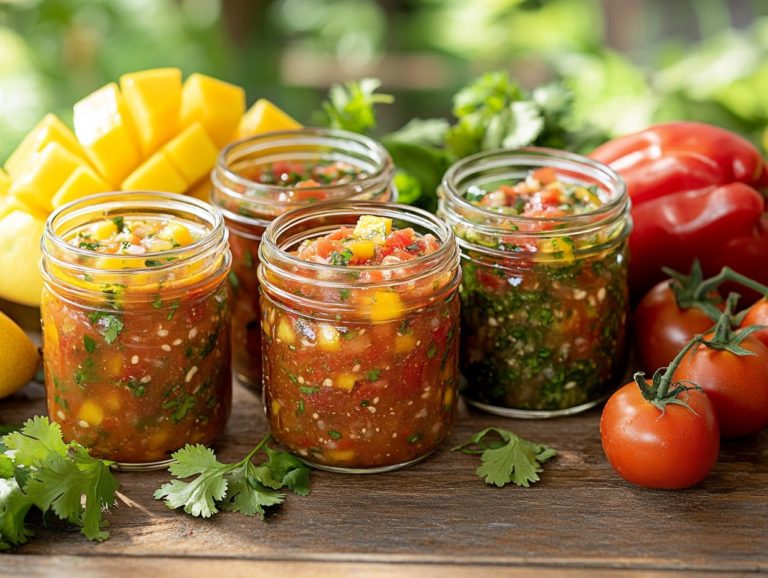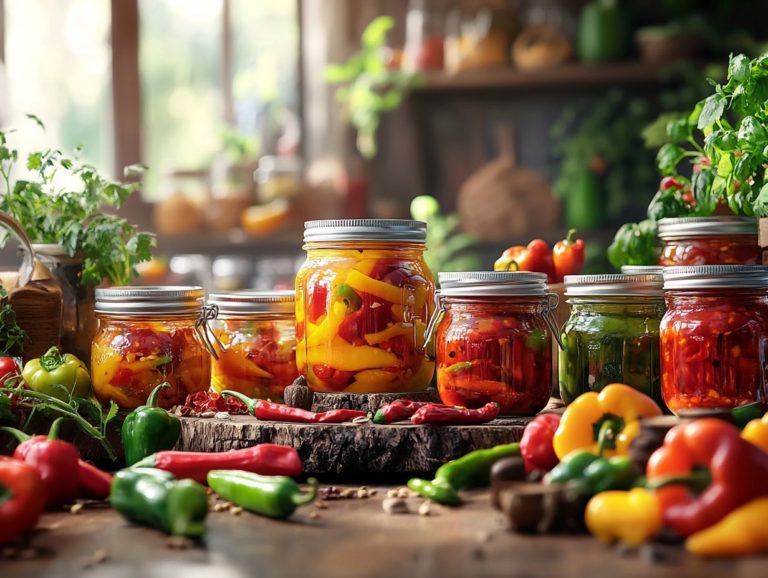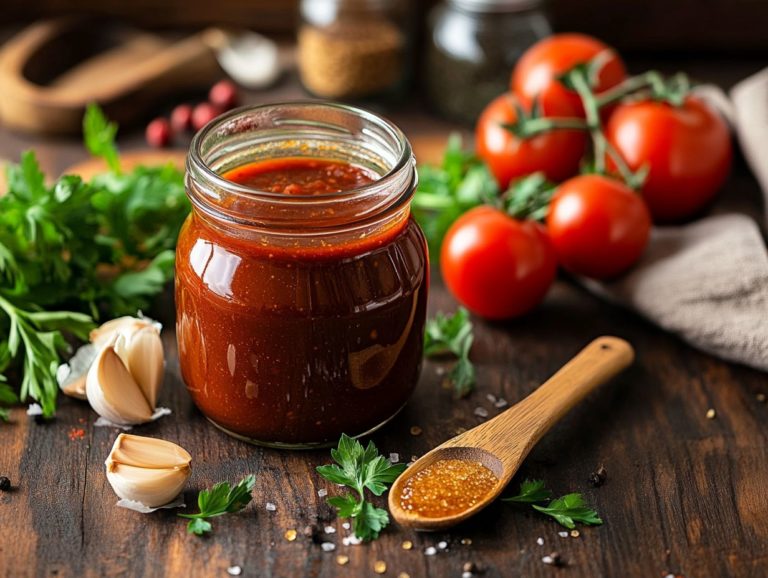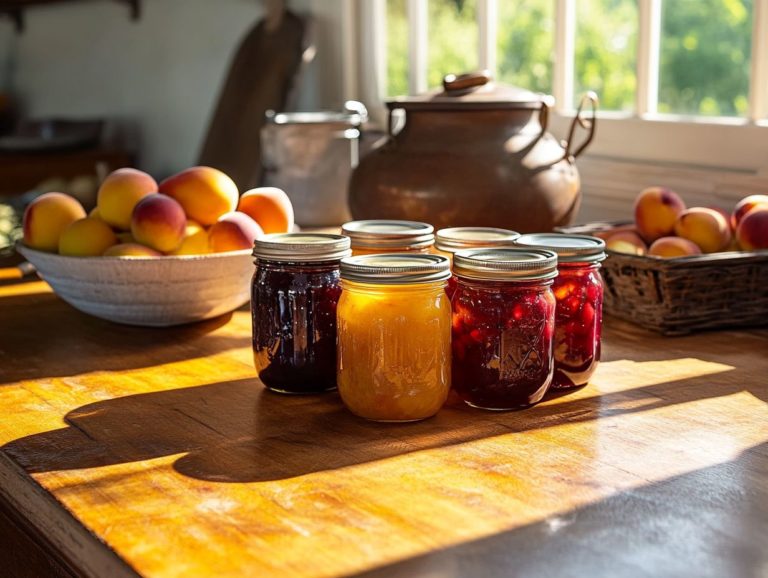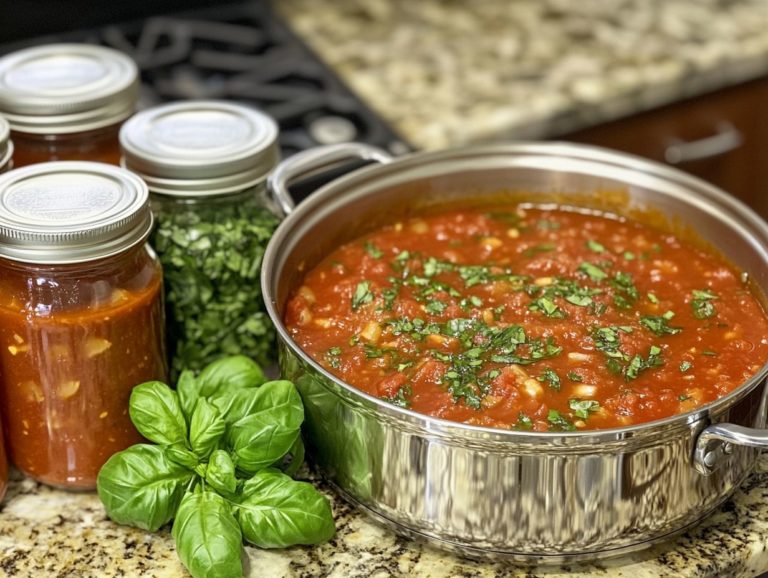Making Dill Pickles: A Quick How-To
Pickling is a cherished culinary craft that elevates fresh vegetables into tangy masterpieces. Dill pickles often reign as a favorite.
Delve into the world of pickling and uncover the myriad benefits of making your own dill pickles at home. From health advantages and cost efficiency to the essential ingredients and equipment required, you ll find a comprehensive guide that walks you through each step.
You ll also discover expert tips to guarantee your pickles achieve perfection every single time. Get ready for an exciting adventure in flavors!
Contents
- Key Takeaways:
- The Art of Pickling
- Benefits of Making Dill Pickles
- Ingredients and Equipment Needed
- Step-by-Step Guide to Making Dill Pickles
- Tips and Tricks for Perfect Pickles
- Frequently Asked Questions
- What ingredients do I need to make dill pickles?
- Do I need to sterilize my jars before making dill pickles?
- How long do dill pickles need to ferment?
- Can I use any type of cucumber to make dill pickles?
- What is the difference between dill pickles and kosher dill pickles?
- How do I store homemade dill pickles?
Key Takeaways:
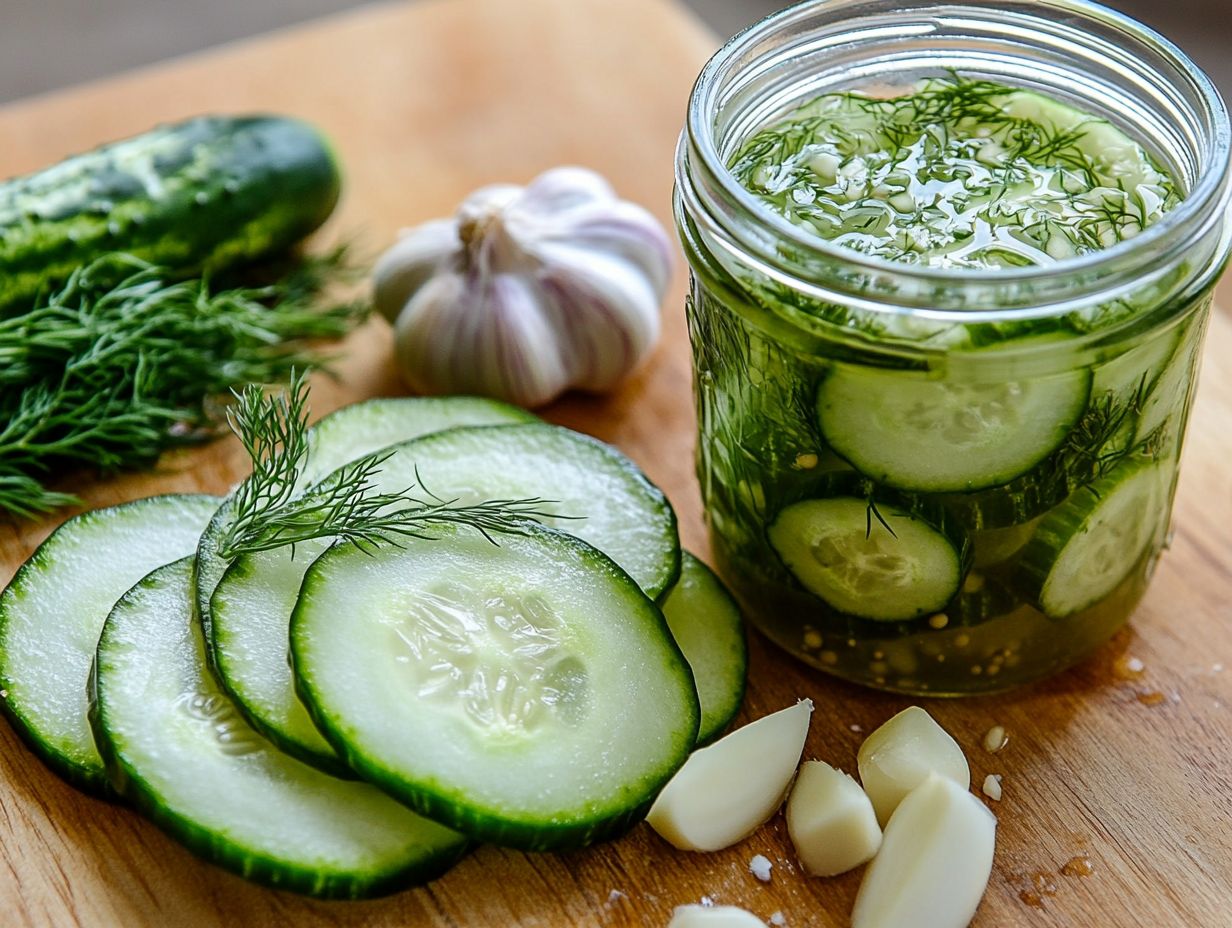
- Pickling is the process of preserving food in a solution of vinegar and spices, creating a tangy and flavorful snack.
- Making dill pickles at home can save money and provide health benefits due to the use of fresh ingredients and control over the pickling process.
- To successfully make dill pickles, you will need essential items such as cucumbers, dill, garlic, and canning jars.
The Art of Pickling
The art of pickling is a delightful culinary tradition that invites you to preserve seasonal flavors. This is especially true when you use fresh ingredients like Kirby cucumbers and aromatic elements such as dill, garlic, and pickling spices.
This time-honored technique not only yields deliciously crisp refrigerator pickles but also elevates your meals with tangy notes perfect for summer snacking or as a topping for a veggie burger.
By grasping the pickling process, you can savor the crunchy texture and vibrant taste of homemade pickles throughout the year. Use a straightforward pickle brine method to capture the essence of each seasonal harvest.
What is Pickling?
Pickling is an art of preservation that invites you to immerse fruits and vegetables in a tantalizing solution of vinegar or brine (a mixture of water, salt, and sometimes sugar used for preserving food), enhancing their flavor while extending their shelf life.
This enchanting process hinges on the chemistry of acids and fermentation. As vinegar s acidity transforms the structure of food molecules, it effectively deters spoilage, all the while imbuing your ingredients with a delightful tang. Picture cucumbers swimming in a brine, absorbing these luscious flavors as they shed moisture, morphing from mere crunchiness into a delightfully crisp bite.
The magic continues with pickling spices, ranging from dill to garlic to mustard seeds, each adding its unique flair, creating an endless palette of flavors. The true versatility of pickled cucumbers shines in dishes like cucumber salad, where they contribute a refreshing zing that elevates every bite.
Benefits of Making Dill Pickles
Creating dill pickles at home presents a wealth of advantages, merging health benefits with significant cost savings. You enjoy a gluten-free snack that is not only delicious but also nutritious.
By making pickles yourself, you can relish a steady supply of tangy, crunchy dill pickles that far surpass the flavor and freshness of store-bought options. Utilizing high-quality ingredients such as Kirby cucumbers, kosher salt, and sugar, you can craft a delightful homemade recipe that elevates your snacking experience.
Health Benefits and Cost Savings
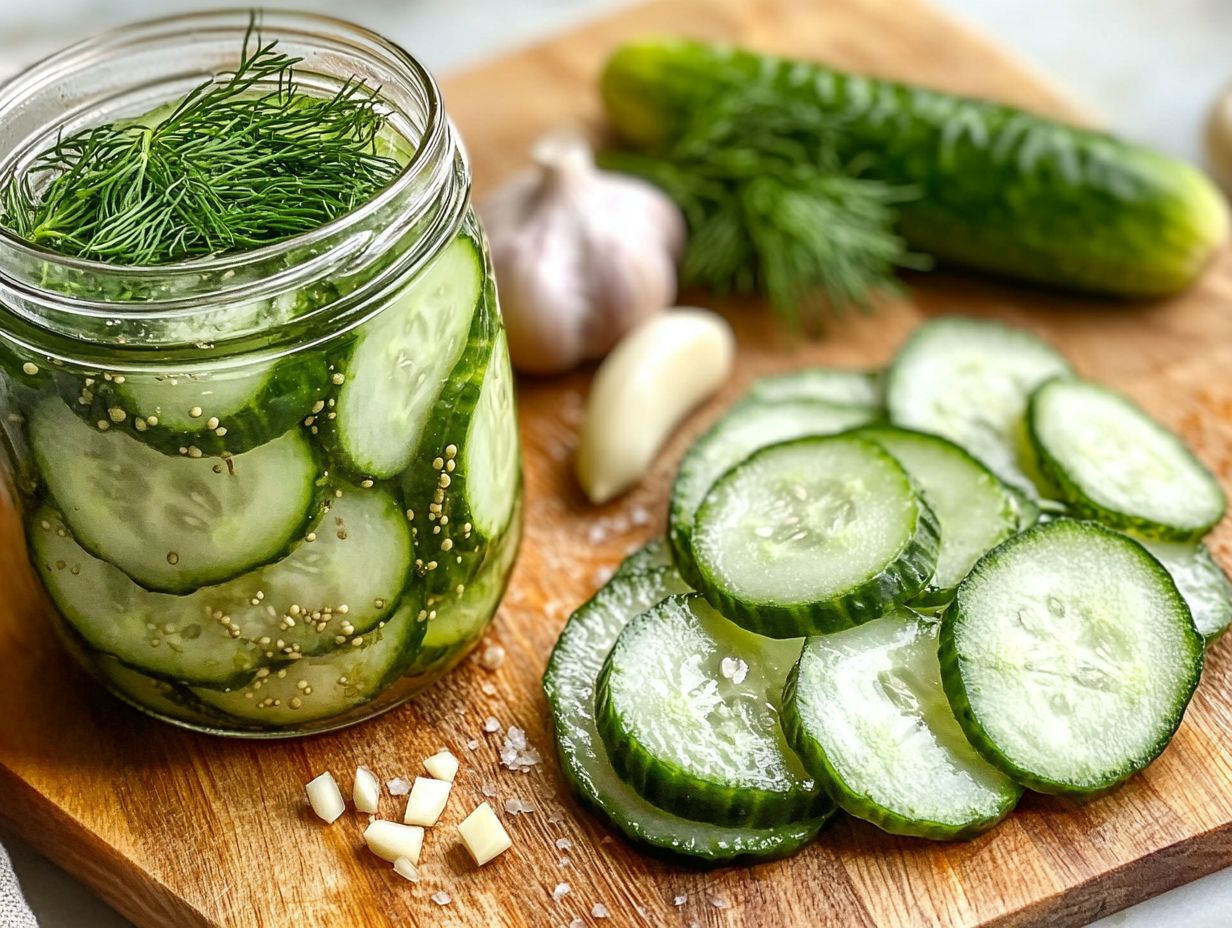
Creating homemade dill pickles offers you a cost-effective way to preserve cucumbers while enhancing your overall health with their myriad benefits.
These delightful snacks can be a true asset for your gut health, thanks to the fermentation process that introduces beneficial probiotics to aid your digestion. Packed with antioxidants, homemade dill pickles help you combat oxidative stress, promoting a sense of overall wellness. As a low-calorie treat, they re ideal for satisfying your cravings without derailing your diet.
When comparing costs, making your own pickles is often more affordable than purchasing store-bought options, especially since the ingredients cucumbers, vinegar, and spices are both accessible and budget-friendly. This not only gives you creative control over flavors but also ensures you know exactly what s in each jar, allowing for a truly personalized touch to your culinary endeavors.
Ingredients and Equipment Needed
To embark on your pickling journey, gathering the right ingredients and equipment is essential for achieving the deliciously crisp tangy flavor of dill pickles that will surely tantalize your taste buds.
You ll want to select fresh Kirby cucumbers, aromatic garlic cloves, kosher salt, sugar, and a selection of pickling spices. Equally important is your choice of equipment. Opt for a cooking vessel crafted from non-reactive materials such as stainless steel, ceramic, or Teflon to ensure optimal results.
Essential Items for Pickling
Essential items for your pickling adventure include high-quality vinegar, aromatic garlic, and an array of pickling spices tailored to your unique flavor preferences.
To truly elevate your pickling experience, consider selecting vinegars like white distilled for a sharp tang, apple cider for a fruity twist, or rice vinegar for a milder approach. Each of these choices significantly influences the final taste, allowing you to explore a delightful spectrum of flavor profiles.
In terms of spices, don t hesitate to experiment with mustard seeds, coriander, and dill. Fresh herbs like thyme or bay leaves can add an extra layer of depth to your creations.
Don t forget to choose non-reactive vessels! Glass jars or food-grade plastic containers are your best friends. These choices maintain the integrity of your flavors and prevent any unwanted chemical reactions during the pickling process.
And remember, sourcing local, organic produce whenever possible ensures the best quality. Consider making a trip to farmer s markets or specialty stores, where freshness truly reigns supreme.
Step-by-Step Guide to Making Dill Pickles
Creating perfectly crunchy dill pickles from scratch is an art that requires careful steps, blending both preparation and the brining process. This journey leads to a delightful end product that you can preserve and store for future enjoyment.
Start by selecting the freshest pickling cucumbers and crafting a vinegar brine infused with aromatic spices. Follow through with precise brining techniques before canning, ensuring that their tangy flavor is beautifully preserved for you to relish later.
Preparation and Brining Process
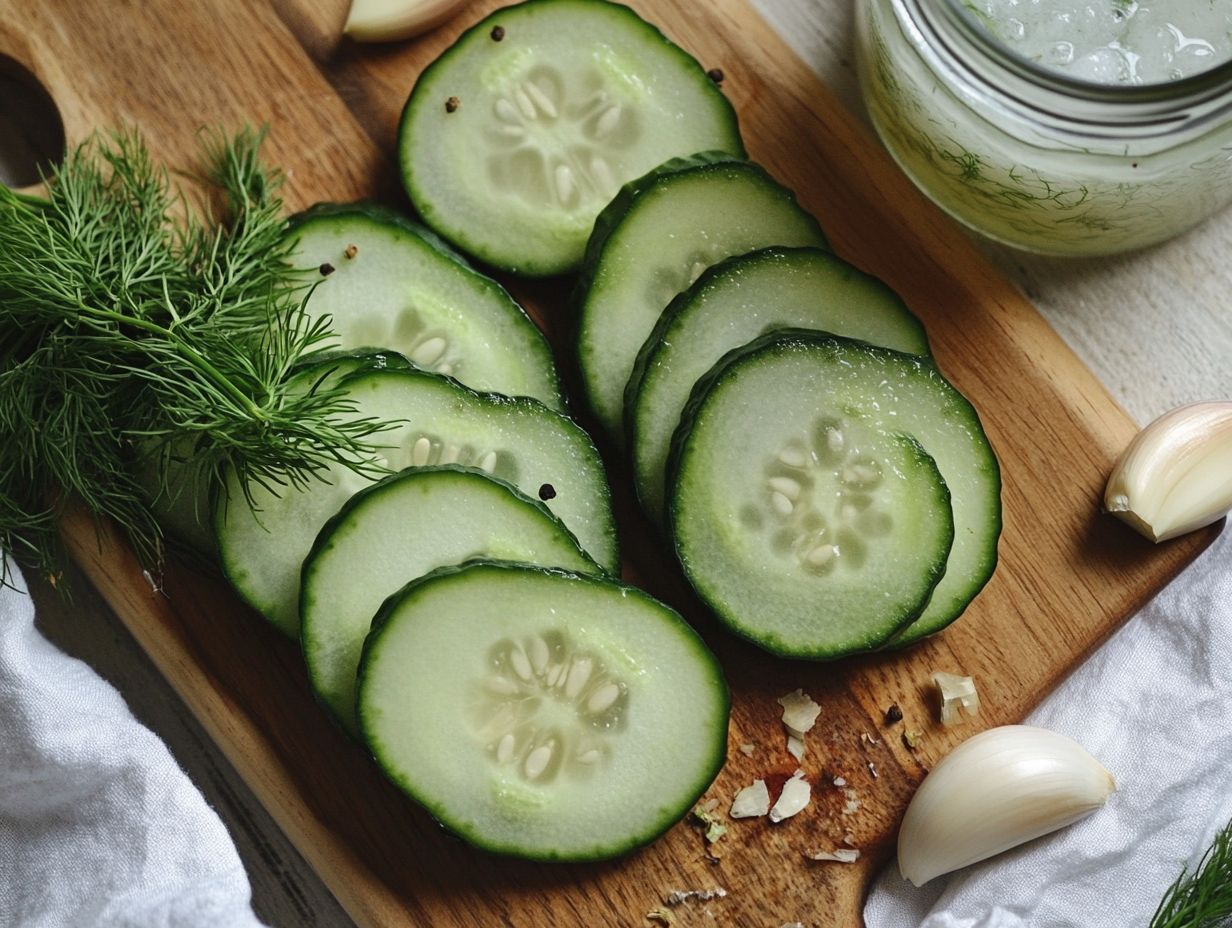
The preparation and brining process for dill pickles is key to achieving that perfect flavor and texture, starting with the selection of fresh ingredients and crafting a well-balanced vinegar brine.
Once you ve gathered those crisp cucumbers, wash them thoroughly under cold water to ensure that any dirt or impurities are removed. After they re clean, cut them into uniform slices or spears. This uniformity is crucial for even brining.
Now, onto the vinegar brine mix equal parts water and vinegar, adding a delightful blend of spices like dill seeds, mustard seeds, and garlic for that aromatic kick. Soak the cucumbers in this flavorful brine for at least 24 hours. This soaking allows them to absorb all those delicious flavors, leading to a perfect pickle.
You might come across various recipes that suggest different spice ratios or even the addition of sugar for a hint of sweetness. This adaptability means you can tailor the process to suit your personal taste, elevating your pickling game to a whole new level.
Canning and Storing
Canning and storing your homemade pickles are essential steps to ensure their longevity, letting you relish those delightful pickled vegetables for months on end.
This meticulous process starts with selecting high-quality cucumbers and making sure all your equipment is sanitized. Sterilizing your jars is critical; it eliminates any harmful bacteria that could spoil your hard work. Utilizing proper sealing methods, such as a water bath or pressure canner, helps create an airtight seal that preserves freshness beautifully.
Adhering to safety guidelines is crucial to prevent spoilage, so it’s wise to follow tested recipes closely. Once your pickles are canned, store them in a cool, dark place to maintain their flavor and satisfying crunch. For the best experience, remember to refrigerate opened jars and enjoy them within a few weeks.
Get ready to enjoy your homemade pickles!
Tips and Tricks for Perfect Pickles
To make the perfect pickles, follow some essential tips. This will elevate your homemade pickles with a delightful flavor and that crunchy dill texture everyone loves.
By experimenting with different seasoning combinations and fine-tuning how long to soak in salt water, you can craft a batch of pickle chips that perfectly aligns with your unique taste preferences.
Expert Advice for Best Results
For the finest results in crafting homemade dill pickles, expert advice can guide you. It helps optimize that delightful flavor profile while ensuring a satisfying crunch that tickles your taste buds.
Tap into the wisdom of seasoned picklers to uncover invaluable tips. The ideal spice ratios often include a harmonious blend of dill seeds, peppercorns, and garlic that enhance the taste without overshadowing the cucumber s natural essence.
When selecting cucumbers, choose the right variety. Pickling cucumbers, such as Kirby or Persian types, are recommended for their firm texture and petite size, making them perfect for brining.
If you run into issues like cloudiness in the brine or softened cucumbers, experienced picklers suggest ensuring your equipment is properly sterilized and that you re using the right amount of salt.
Ultimately, this pickling journey invites you to experiment with spices and flavors. Personalize each batch for unique satisfaction!
Frequently Asked Questions

What ingredients do I need to make dill pickles?
To make dill pickles, you will need cucumbers, dill, garlic, vinegar, water, salt, and pickling spice. Feel free to add other spices or herbs for extra flavor.
Do I need to sterilize my jars before making dill pickles?
Yes! Sterilizing your jars is important to prevent bacteria. You can do this by boiling the jars and lids in a large pot of water for 10 minutes.
How long do dill pickles need to ferment?
Dill pickles typically need to ferment for 1-2 weeks. However, the exact time may vary depending on the temperature and ingredients used. It’s best to taste a pickle after a week to see if it has reached your desired level of tanginess.
Can I use any type of cucumber to make dill pickles?
No, it s best to use pickling cucumbers for making dill pickles. These cucumbers are smaller, firmer, and have fewer seeds, making them ideal for pickling.
What is the difference between dill pickles and kosher dill pickles?
The main difference between dill pickles and kosher dill pickles is the type of salt used. Kosher dill pickles are made with kosher salt, while regular dill pickles can use any salt. Additionally, kosher dill pickles are certified kosher and have a slightly different flavor due to the salt.
How do I store homemade dill pickles?
Store homemade dill pickles in the refrigerator to slow down fermentation and prevent spoiling. They can last for several weeks to a few months when properly stored in the fridge.
Ready to pickle? Share your creations with us!

